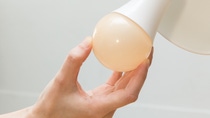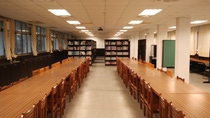Sunvue® low blue lighting: reinventing LED illumination

The history of lighting technology epitomizes that of human beings. While evolving technology has brought a dazzling range of lighting products to meet varied needs, some light sources, when used inappropriately, can be harmful to health.
As many people spend half their days indoors exposed to numerous artificial light sources, increasingly we are coming to realize the negative effects it can have on the eyes. With prolonged exposure to electronic devices – such as mobile phones and computers – we are exposed to blue light which can be found in the visible lights in their screens.
Blue light is a range of high-energy visible light with a wavelength of between 400−500 nanometers. Its strength may reach the retina through the lens causing irreversible damages to photoreceptor cells in retinal microvasculature and retinal pigment epithelial cells through peroxidation reaction. As both cells are non-regenerative, their damage could have serious implications on visual acuity. A University of Toronto study shows that exposure to blue light suppresses the secretion of melatonin, a hormone that influences circadian rhythms. There's also experimental evidence from Harvard University that lower melatonin levels might explain an association with cancer[i].
Despite the prosperity of the LED lighting market, fueled by national policies and energy-saving demands, few people realize that much of blue light exposure arises from LED bulbs and tubes in everyday life. In the China market, for example, WLED dominates most homes and offices. It produces white light by pairing blue LED with yellow phosphor. This situation is further worsened by Chinese preference to cold white light.
“It has taken LED lights only 10 years from lab to everywhere, and its negative effects on eyes have not been seriously discussed until recently.” said Morgan Tsai, Senior Manager, Dispersion and Pigments, BASF Taiwan.
Since 2013, BASF has been working on an innovative blue light screening synthetic material as a possible alternative to traditional rare earth phosphor. Hopefully it will significantly reduce the blue light from LED and provide a much higher color rendering index.

According to Dr. Sean Hong, Head of Advanced Performance of Lighting and Display Optics Laboratory (APOLLO Lab), BASF Taiwan, the candidate material is a fluorescent dye originally used in outdoor signage. A few years ago, the Taiwan R&D team made an attempt to use it in electronic displays and lighting to optimize the spectral structure of artificial light sources. When the technical feasibility was confirmed, further research and formulation experiments were carried out in BASF R&D centers in Germany and Taiwan – Germany was responsible for dye synthesis, while Taiwan focused on material selection. Materials and combinations were tested to adjust the spectrum in five years before the desired formulation was finally achieved. That’s how Sunvue®, the innovative lighting solutions based on BASF's patented organic light conversion material, was born.
For most LED lights in the market, a blue LED is combined with a yellow inorganic phosphor coating. Part of the blue photons generated in the LED is converted into yellow photons which travel through the phosphor layer. The remaining blue photons and the yellow ones combine to generate white light. However, the low blue light secret of Sunvue® lies with BASF’s patented organic yellowish green and red light conversion material. This means more blue photons can be absorbed and converted when travelling through the layer, thus blue light will be further reduced. Compared with conventional WLED lights in the market, the BASF formulation reduces the amount of blue light by 50 to 75 per cent.
Color Rendering Index (CRI) is another important measure of artificial light sources. The index reveals the colors of various objects faithfully under any luminance in comparison with an ideal or natural light source – the closer to natural light sources such as sunlight, moonlight and candle light, the higher CRI.
Thanks to the light conversion material, the spectrum of Sunvue® becomes more complete and closer to that of sunlight, as blue light is absorbed and converted into yellowish green and red lights. The CRI of sunlight is 100, and Sunvue®’s CRI is as high as 95 – it not only faithfully renders the colors of various objects as if under sunlight but also provides a more comfortable and uniform illumination. In contrast, the CRI of conventional lights is about 70-80, where people’s eyes tend to confuse red with orange.
To improve the product’s CRI and efficiency at different color temperatures, BASF has been optimizing the formulation by choosing the most stable and blue-resistant materials and adjusting their proportions. “Sunvue® light-converting lampshade is used on the newly developed table lamp of BASF to ensure a CRI of 95 per cent and above under varied luminance – from 2700K warm white light to 4500K[ii] white,” according to Hong. The material is coated on the lamp housing instead of directly on the light source itself. This helps to remarkably improve blue screening performance, as well as the color stability and uniformity of lights. Moreover, BASF is strongly committed to eye health, and that’s why a non-flickering power solution is used for table lamps and light bulbs to reduce eye strain.

Sunvue® was first launched as BASF’s own brand in Taiwan, in early 2018. Its products include light bulbs, tubes and table lamps. From November 2018, Sunvue® products have been available in Mainland China through e-commerce platforms such as JD and TMall.
“It is not a common practice that upstream chemical companies are directly involved in the development and sale of retail products. This time, BASF will take advantage of our strong R&D capabilities to solve consumers’ pain points by providing more comfortable light sources to improve illuminating quality and protect eye health,” said Tsai.
“More importantly, we hope to change the ways and habits people use illumination. Of course, we are more than willing to develop this market together with downstream light manufacturers if they are interested in the technology.”
[i] https://www.health.harvard.edu/staying-healthy/blue-light-has-a-dark-side
[ii] Kelvin (K) is used here as a unit of measure for Correlated Color Temperature (CCT) of natural light sources to describe the color of light. For instance, the color temperature of sunset is about 2000K; candle light, 2700K; moonlight, 4000K; and daylight, 5000-5500K.
